Plant Reproduction
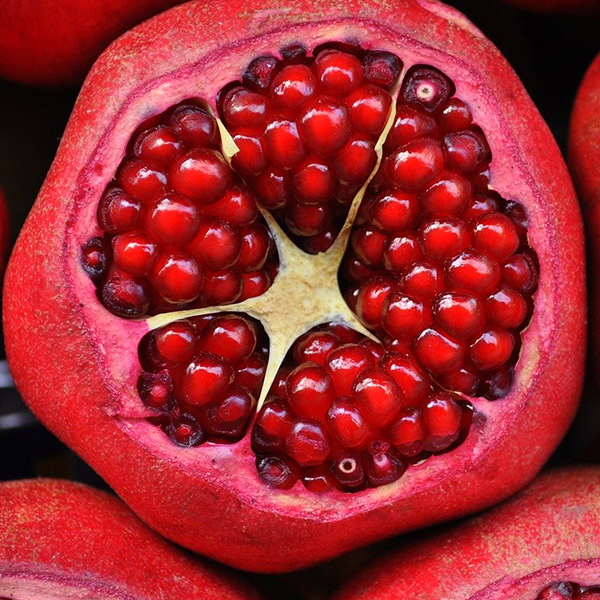
Seeds of a pomegranate fruit (megspl, Pixabay)

Seeds of a pomegranate fruit (megspl, Pixabay)
Learn about pollination and other forms of sexual reproduction in plants. And did you know that plants can also reproduce asexually?
Plants are living organisms. That means they need to reproduce in order to pass on their to future generations. Plants can create through either sexual or asexual reproduction.
Sexual Reproduction
Sexual reproduction requires genetic material () from two parents. The parent plants have male and female sex cells, called gametes. The genetic material from the male and female gametes combines to produce offspring. We call this process fertilization. The product of sexual reproduction are seeds.
Seeds produced through fertilization contain genetic material from both parents. As a result, the offspring are not genetically identical to either of the parent plants. This genetic diversity can help them survive if the environment changes.
Flowering plants reproduce sexually through a process called pollination. Flowers contain male sex organs called stamens and female sex organs called pistils. The anther is the part of the stamen that contains pollen. Pollen contains the male gametes. Pollen must be moved to a part of the pistil called the stigma for reproduction to take place.
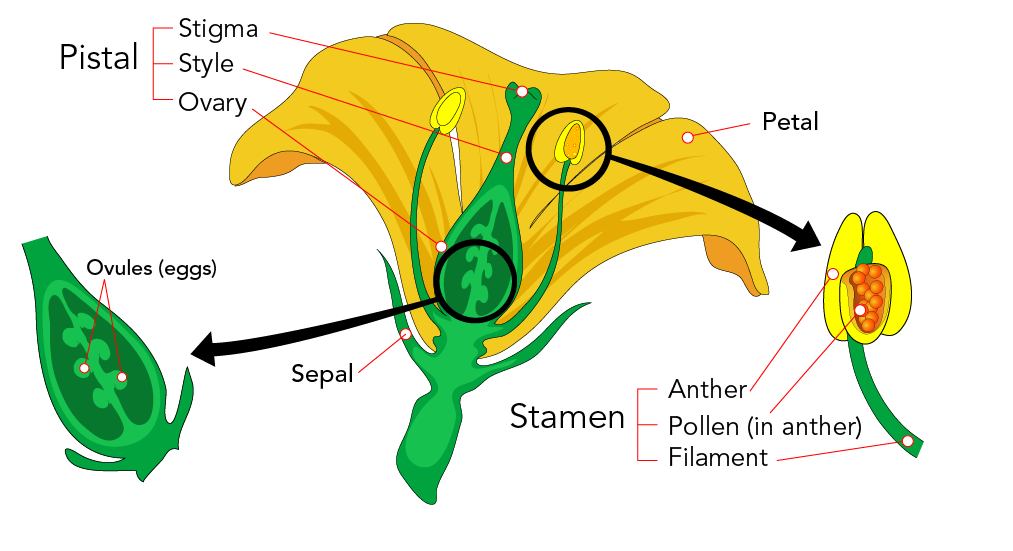
Image - Text Version
Shown is a colour diagram of the reproductive parts of a flower.
In the centre of the image is an illustration of a whole flower. Two areas of this flower are magnified in separate, smaller illustrations in the lower left and right corners. Parts of the flower are labelled with black text connected to small white circles with red lines.
The flower has orange petals, one of which is labelled "Petal." A long, green structure extending up from the centre of the petals is labelled "Pistal," in large font. Three parts of the pistal are labelled in a smaller font. The hollow, almond-shaped chamber at the base is labelled "Ovary". The long, thin, green structure above it is labelled "Style". The wider, indented tip of this is labelled "Stigma".
On either side of the pistal are long, thin, tapered green arms topped topped with yellow oval shapes. One of these yellow parts i has been circled in black, with an arrow pointing to the smaller illustration on the bottom right. This is labelled "Stamen" in large font. Three parts of the stamen are labelled in smaller font. The yellow outer structure is labelled "Anther." A part of the anther is cut away to reveal tiny orange spheres inside. These are labelled "Pollen (in anther)." The thin, green structure holding up the anther is labelled "Filament."
The ovary is also circled, with an arrow leading to the bottom left, smaller illustration. This shows a long green structure through the centre of the ovary, with small oval shapes along each side. These oval shapes are labelled "Ovules (eggs)."
Finally, one of the two thin, pointed green structures below the base of the flower, at the top of its stem, are labelled "Sepal."
The outermost parts of the flower are green structures called sepals. They protect the flower before it opens. Inside the sepals are the petals. These are usually colourful. Petals on flowers are actually modified leaves. Within the petals are the stamens. Each stamen contains a filament topped by pollen-producing cells. The innermost part of the flower is the carpel. The carpel contains the ovary. This is where the eggs, or ovules, are located. The pollen from another flower must enter the ovary and fertilize an ovule in order for a seed to start developing.
Misconception Alert
Not all flowers are large and brightly coloured! Some flowering plants, like grasses, have flowers that are tiny and may even be green, which can make them hard to see.
Sometimes plants pollinate themselves. Other times plants pollinate other plants.
Self-pollination happens when a plant’s own pollen fertilizes its own ovules. Cross-pollination happens when the wind or animals move pollen from one plant to another. The advantage of cross-pollination is that it helps keep a species genetically diverse. Genetic diversity comes in handy when conditions change and organisms need to adapt to the change. Some plants have features that actually prevent self-pollination. This includes things such as pollen and ovules that develop at different times.
Pollinators are animals that carry pollen between plants. Many pollinators are insects, like bees, butterflies, moths and beetles. Some birds, including hummingbirds, also play a part. Likewise, certain mammals, like bats and rodents, move pollen between plants. The colours and smells of flowers often attract pollinators. Pollen will stick to a pollinator’s body as it feeds on the flower’s .
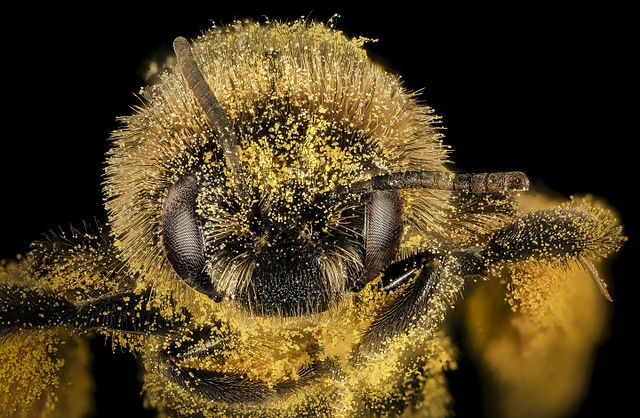
Image - Text Version
Shown is a colour, close-up, photograph of a bee's face, sprinkled with pollen.
This is a portrait of a bee, framing its head and the tops of its wings and torso. Almost all its body is covered in thick, velvety, black and yellow hair caked with bright yellow pollen. Only the dark, round, eyes on either side of its head, and two long, brown antennae are free from pollen.
Fertilization is the next step after pollination. During fertilization, the male gametes from the pollen join with the female gametes in the egg. The egg, or eggs, are found inside the stigma. The scientific word for an egg is an .
Fertilization creates fruit that contain seeds. Some fruits are fleshy, like oranges and watermelons. Others are dry, like acorns or walnuts. Fruits are an attractive food for various animals. After eating fruit, animals expel waste that contains seeds. This way, seeds can take root and grow in places far from the plants that produced them!
Misconception Alert
Some plants have no flowers at all. Flowering plants are a group of plants called angiosperms. There are also non-flowering plants. These include mosses, ferns and conifers.
Asexual Reproduction
Asexual reproduction only requires DNA from one parent. It creates offspring that are genetically identical to the parent. Genetically identical offspring are called clones. Clones lack genetic diversity. This makes them less able to fight disease. It also makes them less adaptable to changes in the environment.
There are different methods of asexual reproduction. They include vegetative propagation and fragmentation.
Vegetative propagation does not need seeds or spores. Instead, offspring grow from a part of the parent plant. In different plants, vegetative propagation happens in different ways. Here are a few examples.
- Garlic, onions and tulip plants all reproduce using true bulbs. These short underground stems are also called scaly bulbs. They have a base that is usually surrounded by modified leaves. These leaves form a papery covering called a tunic. New bulbs grow off of the parent bulb’s base.
- Crocuses reproduce using corms, which are similar to true bulbs. However, a corm doesn’t have as many layers. Corms are used up during the growing season and get replaced by one or more new corms.
- Potato plants reproduce using tubers. Tubers produce new plants from stems or growing points called eyes.
- Ginger plants reproduce using rhizomes. These are stems that grow sideways along the soil or just below the surface. They branch out to produce new points of growth.
- Strawberry plants reproduce using stolons. They look like branches growing along the ground. Stolons anchor themselves to the ground and develop roots. The roots grow into new plants.
Misconception Alert
A tuber isn’t a root. It’s a modified stem that grows underground. Corms and rhizomes are other examples of specialized stems.
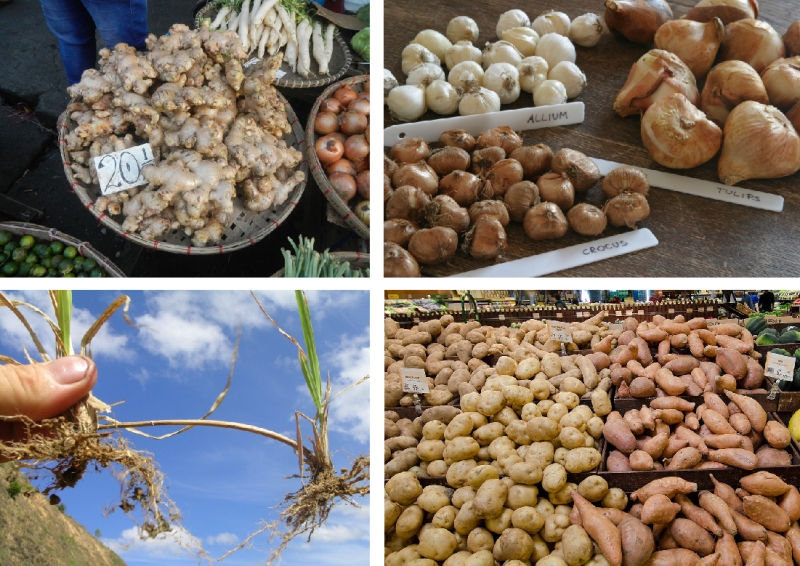
Image - Text Version
Shown are four colour photographs plants that reproduce in different ways.
The images are arranged in a grid. The top left is a basket of ginger with a sign indicating price. The pieces are nubbly beige clumps of rounded shapes.
The top right is three separate piles of flower bulbs on a wooden table. In front of each pile is a white strip labelled with a name. The top pile is "Allium". These are small, round, white bulbs. The pile on the right is "Tulips." These are larger, gold bulbs with pointed tops. The pile on the left is "Crocus." These are the smallest bulbs, and light brown with a squat shape.
The bottom left is a person's hand holding two grass in the air. The plants are connected by a long, thick root. Each plant also has a web of thinner, tangled roots, caked in soil.
The bottom right is a display of potatoes and sweet potatoes in a supermarket. On the left, the potatoes are roughly egg shaped, and pale gold with dark brown eyes. On the right, the sweet potatoes are darker, reddish gold. They are longer and thinner with pointed ends.
Did you know?
Apomixis is a form of asexual reproduction in some species of grasses. The parent plant produces seeds without fertilization.
Fragmentation is another form of asexual reproduction. It involves new plants growing from small parts of a parent plant that fall to the ground. This is one of the ways that plants like liverworts and mosses reproduce.
Horticulturists are people who study plants. They often use asexual reproduction through fragmentation to grow new plants. They do this by cutting a leaf or a stem off a plant and placing it in water or soil. This process is often called propagating from cuttings.
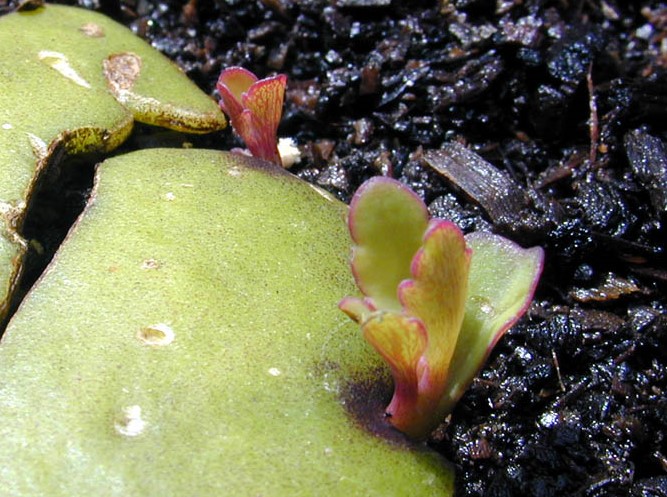
Image - Text Version
Shown is a colour photograph of large leaf lying on soil, with smaller leaves growing out from it.
The leaf is thick and pale green. It is lying diagonally across the image, over dark, moist soil. It is broken in half and the edges are dry and brown. Sprigs of much smaller leaves grow from two places on the edges of the first. One near the broken spot, and one at the bottom edge, where the leaf touches the soil. The new leaves are green with edges and veins of bright pink.
Did you know?
The coco de mer (sea coconut) produces the largest seed of any plant. It grows in the Seychelle Islands. On average, the seeds weigh 25 kg. They can grow to 500 cm in diameter!
Learn More
Earth Rangers provides a list of ten different types of pollinators, their favourite types of flowers, and how the pick up and distribute pollen.
The Plants & The Bees: Plant Reproduction (2012)
CrashCourse video (10:23 min.) covering the different types of reproduction in plants. Angiosperms (flowering plants) are discussed starting at 5:33 min.
Parts of a Flower & Pollination (2015)
Video (3:55 min.) from Peekaboo Kidz on the parts of a flower and the basic concepts of pollination and fertilization are introduced. Suitable for a younger audience, but applicable for older grades as well.
References
BBC Bitesize. (n.d.). Reproduction in plants. Retrieved from https://www.bbc.co.uk/bitesize/guides/z2xg87h/revision/1
Canadian Wildlife Federation. (n.d.). Explore our pollinators. Retrieved from http://cwf-fcf.org/en/resources/encyclopedias/fauna/explore-our-pollinators.html
Chen, D. Y. (1998, September 28). Asexual Reproduction. Retrieved from https://ucmp.berkeley.edu/glossary/gloss6/asexual.html
Koning, R. (1994). Natural Vegetative Propagation. Retrieved from http://www1.biologie.uni-hamburg.de/b-online/ibc99/koning/vegpropn.html
Lambers, H. (2018, November 21). Plant reproductive system. Retrieved from https://www.britannica.com/science/plant-reproductive-system
Lumen Biology for Majors II. (n.d.). Sexual Reproduction in Plants. Retrieved from https://courses.lumenlearning.com/wmopen-biology2/chapter/sexual-reproduction-in-plants/
Lumen Boundless Biology. (n.d.). Asexual Reproduction. Retrieved from https://courses.lumenlearning.com/boundless-biology/chapter/asexual-reproduction/
ProFlowers. (2015, May 29). Flower Anatomy: The Parts of a Flower. Retrieved from https://www.proflowers.com/blog/flower-anatomy